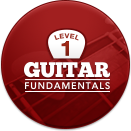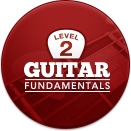
|
Core Learning System
The Guitar Tricks Core Learning System is our third-generation guitar lesson system geared toward the first-time student and those returning to guitar after some time. This program of eight full-length courses is divided into two sections, Guitar Fundamentals and Intermediate Style Courses. Each self-paced course runs between one and eight weeks, and combined they take you from pure basics such as learning to identify the B string - to playing all the major full chord shapes music - all the way to playing guitar at an advanced intermediate level in Blues, Country and Rock.
Since each guitar style requires different techniques, each Style Course will carefully walk you through the learning process for the techniques applicable to that style. Additionally, we explain how each style requires different gear, different amplifier settings, and different tone. This section is particularly useful with tips many advanced players missed in their early education.
|


|
Guitar Fundamentals - Beginners
Guitar Fundamentals One is our guide for the Absolute Beginner. Guitar Fundamentals One takes you from the moment you pick up the guitar all the way to the formation of full major chords. No previous knowledge is required or expected. All lessons have been tested to be truly step by step, at the exact level of difficulty required to encourage rapid skill building
Picking up where Guitar Fundamentals One left off, Guitar Fundamentals Two helps you become a well-rounded beginning guitarist. Guitar Fundamentals Two covers scales, reading music, minor chords, basic song structure, and barre chords. The lessons are more difficult, with the speed slightly increased to build skill. At the completion of this course you will have a strong foundation to pursue any musical style in our thousands of lessons.
|


|
Blues Courses - Intermediate
So you think you've got the blues? Well you have come to the right place! Blues Style Level 1 is designed to cover everything an aspiring bluesman needs to know. To start off, you will learn the fundamentals of the blues, including the 12 bar form, blues chords and chord structure, the essential rhythms, and more.
Once you have covered the basics, the Guitar Tricks blues experts will have you playing blues lead, and even mastering the guitars, amps, and effects that make the blues so bluesy.
In Blues Style Level 2 more advanced techniques are introduced, including new scales and the strategies to use them in the right way. Guitar Tricks Instructors will have you learning the methods of some blues legends, and will conclude with a six-string tour through all the essential blues regions.
|


|
Rock Courses - Intermediate
For those about to rock, Rock Style Level 1 is the place to start!
Guitar Tricks rock experts have broken down everything for you, from rock's roots in blues music to modern theories and techniques like palm-muting and power chords.
After taking you through the popular chords and rhythms, instructors will teach riffing techniques, creating powerful hooks, and finish with some insight on achieving serious rock tone from your gear.
If you have what it takes, Rock Style Level 2 will take things a step further with advanced lead, chord and rhythm lessons. After learning lead scales and techniques like hammer-ons, pull-offs, bending and vibrato, you will be ready for the "Better Rock Musicianship" lesson, a must for any serious rock musician.
|


|
Country Courses - Intermediate
If you're a country fan looking to become a country musician, check out Country Style Level 1.
We think it all starts with the strumming, and after watching the Guitar Tricks instructors break down the magic of the Boom-Chick, Ghost and other country strumming styles, you will be hooked. Country Barre chords, techniques and styles are presented in a clear step-by-step series of lessons that will soon have you learning popular songs and even crafting some of your own.
Country Style Level 2 will go beyond the basics, with the CAGED chord system, chord inversions, hybrid picking and even more. To add to your gig-bag of tricks, instructors will teach you Rhythm Guitar Like The Masters, where you will hone in on your favorite picker's style.
|

|
Learn Your Favorite Songs
Once you have the basics down, a great way to improve your playing and impress your friends is to learn your favorite songs. The Guitar Tricks team has chosen an array of our favorite guitar tunes, and we are adding to the list all the time.
Our selections cover all genres, and feature beginner level songs all the way up to the challenging ones you have always wanted to master. Like all other Guitar Tricks lessons, instructors break down the concepts and guide you through the process in the easiest possible way.
|

|
For Experienced Guitarists
For the advanced guitarist, finding an online resource that can consistently challenge your abilities and help you grow as a musician is hard. Yet Guitar Tricks does just that. We hand-select instructors who have the knowledge and experience to teach you the tips and techniques that can breath new life into your playing.
No matter what your style is, the "buffet" of choose-your-own topics and lessons will improve your playing and make you a better musician. Guitar Tricks is like a giant stack of guitar books and magazines, only better: completely organized, cross-referenced, with full video examples.
We can help you take your understanding of the guitar to a new level, and make you a better musician.
|

|
Learn Guitar Styles
Our number one tip for the experienced guitarist is this: borrow from another style. Stylistic and regional differences in guitar technique can lend a fresh perspective to your playing. Do you play country? Our metal instructors have some picking ideas to speed up your technique. Do you play rock? Our country instructors have string bending lessons that will add fluidity to your style. Guitar Tricks finds instructors who are true masters of their style, and then give them a forum to show you everything that style has to offer.
Browse Genre Studies Lessons:
|

|
Artist Studies
If you like to think more in terms of artists who inspire you, you will enjoy Guitar
Tricks' Artist Inspiration Series which teaches you styles and techniques by
popular artists that have inspired us all as guitarists. These lessons take an
in-depth look at the specific techniques, tone settings, note choices and rhythm
tricks each artist uses to make that signature sound.
Sample Artist Inspiration Titles:
|

|
Top 20 Techniques
Every experienced guitarist loves to add to his bag of tricks. The Guitar Tricks
Technique Reference Library allows you to quickly find and master popular techniques
from every style. Whether it's alternate picking, finger picking, hybrid picking,
sweep picking, natural harmonics, pinch harmonics, artificial harmonics or any
conceivable guitar technique, you'll find it in the Technique Reference Library.
Sample Technique Reference Lessons:
|








